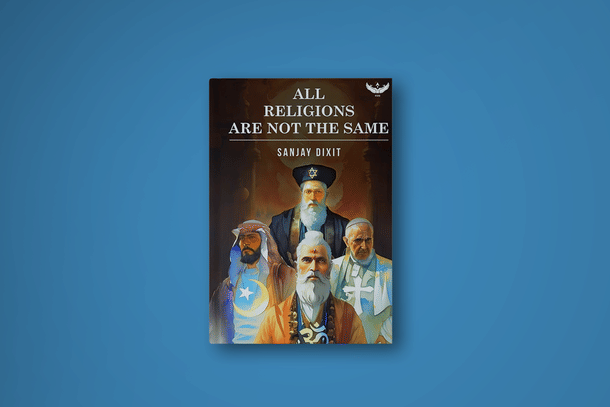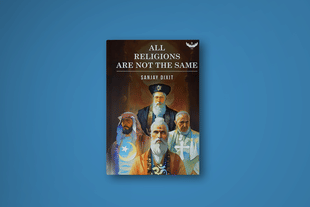Books
Defogging The Confused Hindu Mind On Why All Religions Aren't The Same
R Jagannathan
Jan 01, 2024, 12:52 PM | Updated 12:52 PM IST
Save & read from anywhere!
Bookmark stories for easy access on any device or the Swarajya app.


All Religions Are Not The Same. Sanjay Dixit. Garuda Prakashan. 2023. Price Rs 399. Pages 192.
For India’s confused Hindus, there seems to be an innate need to seek artificial harmony between religions by validating them all.
Brought up on a diet of Upanishadic wisdom that talks of Vasudhaiva Kutumbakam (The world is one family) and Ekam Sat, Viprah Bahuda Vadanti (Truth is one, but the wise refer to it differently), our Pavlovian response to real religious differences is to proclaim that “All religions are essentially the same.”
Our faux secularism expects us to internalise this untruth for ensuring communal harmony.
If you are one of those Hindus, Sanjay Dixit is likely to pour cold water on you with his book, which is boldly titled with the exact opposite message: “All Religions Are Not The Same”.
This should actually have been obvious, for there are real differences between the belief-based Abrahamic religions, which indulge in aggressive conversions and hold a binary view of the world, and Dharmic ones like Hinduism and Buddhism, which tend to focus on seeking higher truths based on experiential knowledge and not just scriptural dogma.
But there seems to be something in the Hindu DNA that encourages wilful blindness to the dangers lurking in the Abrahamic worldview that ultimately can only result in violence and bigotry.
Dixit’s book is the right antidote to wishful Hindu thinking about the alleged sameness of all religions. The sooner we banish this nonsensical idea from our muddled heads, the easier it will become to protect Dharma and our essentially plurality as a civilisation.
The book’s very first chapter will debunk the myth, by explaining how the foundational concepts of Abrahamic religions and Dharmic ones are diametrically opposed. Their frameworks are different, and their assumptions about creator and created are at variance.
As Dixit notes, “the Sanatana system in its essence is an experiential framework that creates a knowledge system, whereas the Abrahamic systems belong to a belief framework”. The former is scientific, the latter largely unscientific. The former’s truths flow from observation and experience and the latter’s from scripture and the lives and messages of historical persons or prophets.
The Dharmic systems use a descriptive framework, while Abrahamic ones use a prescriptive one. Dharma has an open architecture for anyone to build on existing knowledge, while Abrahamic religion comes with a closed architecture, where additional knowledge can only be built on the edifice of accepted dogma.
One is inherently inclusive, the other exclusivist. The creator and creations are part of the same reality in Sanatana systems, but in the Abrahamic world, the creator is a judgmental person who demands your exclusive devotion to him (it is always a “him” in Abrahamic systems) and no one else.
The book can roughly be divided into three broad segments with a total of 25 chapters, with the first segment (of eight chapters) outlining how the Abrahamic systems are different from Dharmic ones. They are different in how they interpret information, their attitudes to science, time and logic concepts.
The Abrahamic world uses linear time, and assumes that we have one life, at the end of which a jealous god will judge you and despatch you to heaven or hell. In Indic systems, the concept of time is cyclical.
The second segment of five chapters explains the Sanatana system in detail, including the nine darshanas, the nirguna (formless) and saguna (with form), the Hinduism versus Hindutva debate, and Hindu symbolism.
The third segment — which comprises four parts and 12 chapters — is very important. It is vital for understanding the consequences of Abrahamic principles and assumptions that have real-world (and often negative) consequences for all those who do not accept its “truths”.
This segment discusses the evolution of monotheism, which, it turns out, is not about one god, but the “only god”, where all other ideas about god are deemed not only false, but deserving of punishment in this world or the next.
Little wonder, Abrahamic assumptions about the “one true god” invariably end up justifying violence against those who do not believe their dogmas.
Parts five and six in the third segment detail the wars fought between Abrahamic religions, and how Islam is the ultimate distillation of Abrahamic monotheism where jihad is a permanent war against non-believers. Even the so-called peaceful Sufi is a mythical creature in Islam.
The book, which has an excellent foreward by Vedic scholar Pt Vamadeva Shastri, better known as David Frawley, is a must-read for Hindus, for it takes forward the illuminating works of Ram Swarup and Sita Ram Goel on Hinduism and Monolatrous faiths in one slim paperback volume.
One can read this book in the course of a Delhi-Mumbai flight or while waiting at airport terminals, but it will make all the difference between making you a knowledgeable sanatani or a dumb regurgitator of empty slogans about the sameness of religions. It is essential reading for Hindus who want their civilisations to survive and prosper.
Dixit, who is a retired IAS officer of the Rajasthan cadre, is also the man behind The Jaipur Dialogues, which seeks to counter the anti-Hindu narratives of the Left-Liberal elite.
Jagannathan is former Editorial Director, Swarajya. He tweets at @TheJaggi.




